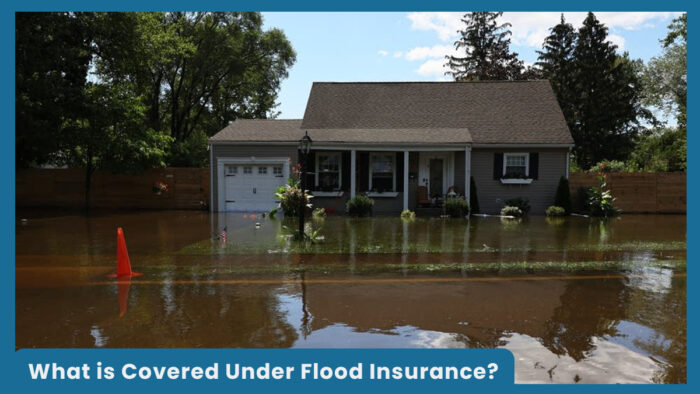What is covered under flood insurance – Most standard homeowners and renters insurance policies do not include protection against flood damage. If you live in an area where flooding is a concern, it is important to get separate flood insurance.

Flood insurance helps cover damage caused by events like heavy rain, overflowing rivers or lakes, and storm surges from hurricanes. It pays for repairs to your home’s structure and can also help replace personal items that are damaged or destroyed.
Even a small amount of flooding can lead to expensive repairs. To avoid high out-of-pocket costs, it’s a good idea to consider flood insurance as an added layer of financial protection. Here is what you need to know about how it works.
What Does Flood Insurance Cover?
Flood insurance is designed to protect your home and personal belongings from certain types of water damage. According to the National Flood Insurance Program, a flood is defined as an excess of water covering land that is normally dry. This type of insurance typically covers damage caused by the following situations:
- Overflow from a river, lake, or bay
- Storm surges from hurricanes
- Heavy rainfall that collects faster than it can drain
- Mudflows
- Snowmelt that enters your home
Most standard homeowners, renters, condo, and mobile home insurance policies do not include flood coverage. If you live in an area where flooding is a concern, purchasing a separate flood insurance policy is often necessary for full protection.
Types of Flood Insurance Coverage
Flood insurance typically comes in two forms: building coverage and contents coverage. Both types carry separate deductibles, which is the amount you must pay out of pocket when you file a claim.
Building Coverage
Building coverage protects the structure of your home. It is similar to dwelling coverage under a standard homeowners policy and may include:
- Electrical and plumbing systems
- Water heaters and furnaces
- Foundation walls
- Built-in appliances and cabinets
- Permanently installed carpets
- Detached garages
- Fuel and well water tanks
- Solar energy systems
- Staircases
- Window blinds
The National Flood Insurance Program (NFIP) offers up to $250,000 in building coverage.
Contents Coverage
Contents coverage protects your personal belongings, much like personal property coverage on a homeowners or renters policy. Covered items typically include:
- Clothing
- Furniture
- Electronics
- Curtains
- Washers, dryers, and microwaves
- Portable air conditioners
- Carpets installed over wood floors
- Valuable items such as original artwork or furs (up to $2,500)
NFIP policies provide contents coverage on an actual cash value basis. This means your reimbursement is based on the current value of your items, not what it would cost to buy them new. For example, if your older recliner is damaged in a flood, your policy will cover the cost of a used one in similar condition. NFIP contents coverage is available up to $100,000.
Flood Insurance Coverage Beyond the NFIP
Private insurance companies may offer broader coverage and higher limits than NFIP policies. For instance:
- Neptune Insurance provides building coverage up to $4 million and contents coverage up to $500,000
- Chubb offers total flood coverage limits up to $15 million
- Some private insurers cover your belongings on a replacement cost basis, which means you could replace damaged items with new ones rather than used equivalents
Private flood insurance may also offer additional benefits, such as living expenses or coverage for swimming pools, that NFIP policies do not include.
What Flood Insurance Does Not Cover
Flood insurance through the NFIP comes with limitations. It does not cover:
- Water damage not caused by natural flooding: The NFIP covers only flood events that affect at least two acres or two properties. Water damage from a burst pipe or an overflowing bathtub is not included. In those cases, your homeowners policy may apply.
- Swimming pools and hot tubs
- Decks and patios
- Landscaping and fences
- Septic systems and wells
- Cash, coins, or valuable documents
- Most finished areas of basements, including furniture, electronics, and flooring
- Temporary housing and living expenses: If you need to stay in a hotel or rental while your home is repaired, NFIP policies do not cover those costs.
- Vehicles: Flood insurance does not cover cars or other vehicles. However, if you have comprehensive coverage on your auto insurance, flood damage to your vehicle may be covered.
Some private insurers offer additional protections. For example, Neptune and Aon Edge may cover temporary living expenses and certain outdoor features.
Is Flood Insurance Required?
Flood insurance may be required in some cases. For example:
- Mortgage lenders usually require it if your home is in a high-risk flood zone
- If you have received federal disaster assistance in the past, you may be required to maintain flood coverage to qualify for future help
Even if you are not required to carry flood insurance, it may still be a smart decision. Just a few inches of water can lead to thousands of dollars in damage.
To see whether your home is in a high-risk flood zone, visit the Federal Emergency Management Agency’s Flood Map Service Center and search your address.
How Much Flood Insurance Do You Need?
The amount of coverage you need depends on the size and structure of your home as well as the value of your belongings. A licensed insurance agent can help estimate the right level of building coverage. You can also create a home inventory to assess the value of your personal items and determine how much contents coverage you need.
If the NFIP does not provide enough protection, you may want to ask about excess flood insurance. This type of policy adds extra coverage on top of your NFIP limits. Providers such as Wright and SWBC offer these plans. You can also choose to skip the NFIP and go directly to a private flood insurance provider if you need higher limits or broader coverage.
How Much Does Flood Insurance Cost?
The average cost of a federal flood insurance policy is around $899 per year. Your exact rate may vary based on:
- Your location
- The size of your home
- Local flood risk
- Type and amount of coverage
To find more information or compare state-by-state pricing, visit the guide on flood insurance costs.
How Flood Insurance Works
Flood insurance works like most other insurance types. You pay a premium in exchange for financial protection if a covered flood event occurs. To receive a payout, you must file a claim with your flood insurer. This usually involves calling your insurance provider or agent, providing the date of the flood, and describing the damage.
An insurance adjuster will inspect your home to assess the extent of the damage. The insurer will then determine how much coverage applies based on your policy. For example, if you only have building coverage, contents like clothes or electronics will not be reimbursed.
Once your claim is approved, you will receive a payment minus any applicable deductible. This money can be used to repair your home or replace damaged items.
How to Buy Flood Insurance
There are two main ways to get flood insurance:
- Through the NFIP: The NFIP works with about 50 insurance companies. If your community participates in the program, you may be able to buy coverage from your current homeowners insurer. You can check whether your area qualifies by visiting FEMA’s website.
- From a private insurer: If NFIP coverage is unavailable or insufficient, private insurers offer an alternative. These policies may include higher limits and extra features, often at competitive prices.
To explore your options, speak with a local independent insurance agent who can help you find the right policy for your needs.



